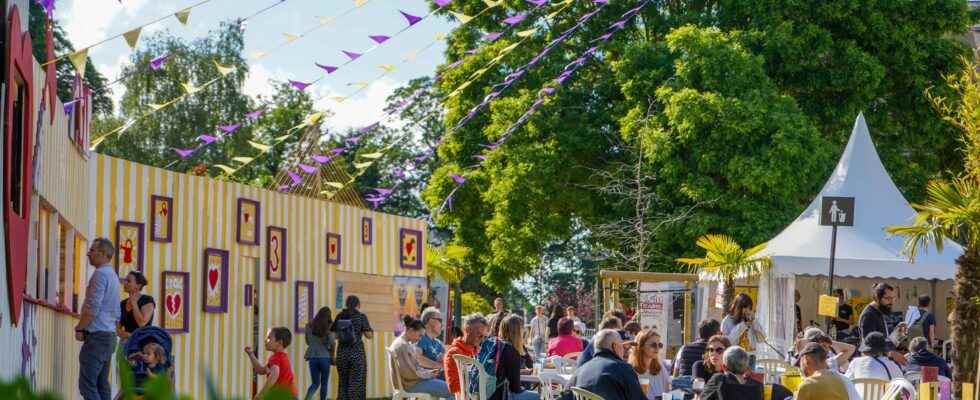Laval (Mayenne), November 19, 2022. Residents are discovering the face and new uses of the former Crédit Foncier, converted into a third place opening onto a garden. The building, renamed Le Quarante, houses, over 8,600 square meters, not only the conservatory of the agglomeration but also a café, shared offices, a performance hall, a Fab Lab, a Micro-Madness these digital museums which are spreading in France and a media library. “With this hybrid space, we are breaking the codes of classic cultural places which can intimidate certain audiences”, affirms Florian Bercault, mayor (various left) of Laval and president of the intercommunality.
A rehabilitation at 27 million euros, which benefits from the Action heart of the city program, piloted by the National Agency for Territorial Cohesion (ANCT). Launched in 2018 with an envelope of 5 billion euros, and renewed until 2026 in order to strengthen the attractiveness of medium-sized cities, it supports 234 municipalities through 6,000 actions, some of which contain a “Culture” section. A welcome boost that does not say everything about the breath of renewal that has been going through this sector since the health crisis.
“During the Covid, the absence of common and festive times highlighted how much cultural life is indeed essential to us. But today, we feel a difficulty for the public to return to traditional offers, which leads to a drop in attendance”, raises Mariette Sibertin-Blanc, lecturer at the University of Toulouse 2. In the light of this particular context, “many cities again consider culture as being able to be a driving force for local social projects” , observes the researcher, who is particularly interested in the strategy of small municipalities.
Proof of a strong comeback of this area in the concerns of elected officials, the Association of Small Towns of France (APVF) created in 2021 a dedicated commission. “The Covid crisis has shown that we had to work twice as hard to rebuild social ties with our citizens. This commission makes it possible to put this dimension back at the heart of the development policies of our territories”, explains Patrick Malavieille, mayor (PC) of La Grand-Combe (Gard) and referent of the APVF on these questions.
“The first graffiti will flourish under bridges”
To arouse curiosity again and bring people together, small and medium-sized towns are more willing to take over public space. Thus, in Laval, a manifesto on urban art was signed last spring between elected officials, artists, associations, patrons and social landlords. “The first graffiti will flourish under bridges, on high buildings”, rejoices Florian Bercault.
Heritage enhancement is also being reinvented. In Vitry-le-François (Marne), the former prison, closed since 1926, will be transformed by 2025 to host exhibitions, conferences and… an e-sports hall. “In many small towns, the enhancement of heritage serves as a starting point for other projects that are part of a more contemporary dynamic”, says Mariette Sibertin-Blanc. And to mention Aubusson (Creuse), where the International City of Tapestry, opened in 2016, has stimulated original collaborations, such as the agreement signed with the Tolkien Estate for the production of 14 tapestries, the thirteenth of which was unveiled this fall, around the graphic work of JRR Tolkien, the author of Lord of the Rings.
If the contents are dusted off, the methods of developing these policies are also shaken up. Since September 2021, the Cuesta cultural urban planning cooperative has been commissioned by the ANCT to support four cities: Mantes-la-Jolie (Yvelines), Niort (Deux-Sèvres), Bourges (Cher) and Guichen Pont-Réan (Ille-et -Vilaine) in the implementation of participatory approaches in order to rethink their actions. A co-writing that took place in two stages: a first to gather the voices of citizens and produce a portrait of the territory and its needs; a second to establish action plans. In Bourges, for example, the works suggested a “Festival of places” which will animate all the districts and not only the city center.
“Do not make culture an adjustment variable”
“The challenge is to extend this dialogue with the inhabitants, raises Agathe Ottavi, co-founder of Cuesta in 2015. A few years ago, our discourse on an art useful to the territories, which seeks to respond to local issues, did not hit home “, she recalls, happy to see the trend reversed little by little. However, “many cities still have a policy based on equipment under management and programming that sometimes competes with local players. Should each city have a cultural programmer or rather a facilitator, a cultural cooperator? ?” she asks.
“For cities in our stratum, relying on the local fabric and integrating into a larger scheme, at the level of the department in particular, are essential things”, considers for his part Patrick Malavieille. A harmony that is all the more necessary at a time when communities are faced with inflation. “More of us than before think that culture should not be made the adjustment variable of our budgets, believes the mayor of La Grand-Combe. On the contrary, it is one of the keys to our future. , not only to improve the lives of the population on a daily basis, but also in terms of economic benefits and added value for our image”, assures the city councilor.
More than just the economic dimension, it is a question, according to Agathe Ottavi, of “reconnecting culture to other public policies”, in social and urban matters in particular. All without neglecting the role of the artists, who have a thousand and one ideas in their wallets to get the inhabitants on board. “In the transition policies at work, we must stop considering culture as the last wheel of the carriage, it is an exceptional wealth”, continues Agathe Ottavi. And, according to her, small and medium-sized towns, “more flexible and more agile”, play a pioneering role in this change of method.
An article from the special issue of L’Express “Find the city that suits you”
